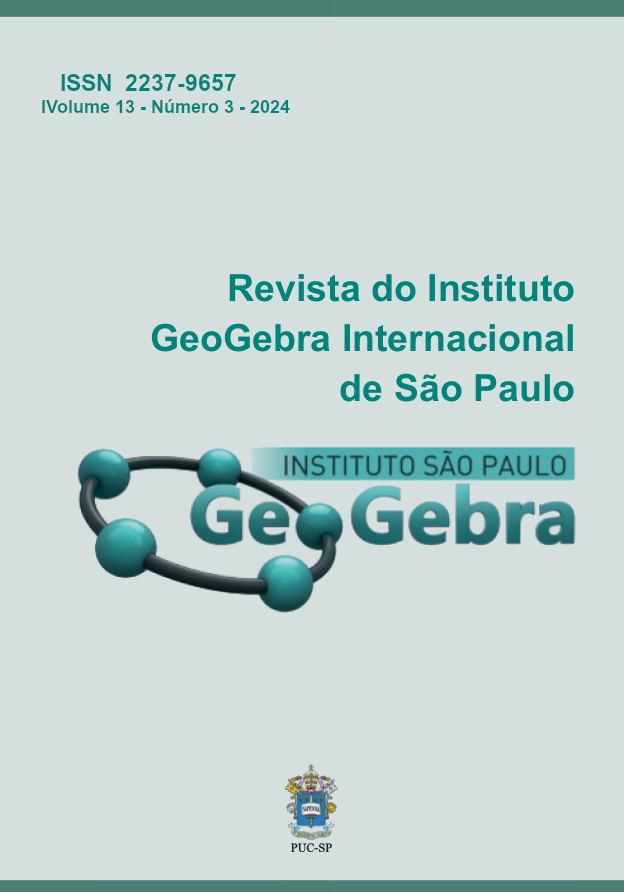The Rubik’s cube and GeoGebra: a visual exploration of permutation groups
DOI:
https://doi.org/10.23925/2237-9657.2024.v13i3p027-044Palabras clave:
Rubik's cube, Group Theory, Permutation Groups, GeoGebraResumen
This article aims to use the construction of the Rubik’s Cube in GeoGebra as a primary tool for visualization and manipulation in the teaching of permutation groups in Abstract Algebra. We bring a brief discussion about the concept of group, aspects of the Rubik's cube, the Rubik’s group as a group of permutations and possibilities for its exploration in GeoGebra. Based on this study, we recognize the potential to delve into permutation groups in Abstract Algebra through a visual interface that associates their properties with a tangible and manipulable object. Additionally, there is the potential for simulating their movements using Dynamic Geometry software, such as GeoGebra.
Citas
Bandelow, C. (1982). Inside Rubik’s cube and beyond. Birkhäuser Boston.
Carter, N. C. (2009). Visual Group Theory. Bentley University.
Chen, J. (2004). Group Theory and the Rubik’s Cube. (Lecture notes). Texas State Honors Summer Math Camp.
Davvaz, B. (2021). Groups and Symmetry: theory and applications. Springer. https://doi.org/10.1007/978-981-16-6108-2
Garcia, A., & Lequain, Y. (2002). Elementos de Álgebra. Projeto Euclides. IMPA.
Gonçalves, A. (1995). Introdução à Álgebra. Projeto Euclides. IMPA.
Joyner, W. D. (1997). Mathematics of the Rubik’s cube. Faculty of Physics, University of Warsaw.
Joyner, W. D. (2008). Adventures in Grout Theory: Rubik’s Cube, Merlin’s Machine, and other Mathematical Toys. The Johns Hopkins University Press.
Travis, M. (2007). The Mathematics of the Rubik's Cube. University of Chicago.
Schültzer, W. (2005). Aprendendo Álgebra com o Cubo Mágico. V Semana da Matemática da UFU. UFSCar.
Sousa, R. T, Alves, F. R. V., & Aires, A. P. (2023). Categorias de Raciocínio Intuitivo no ensino de parábolas: Uma prática estruturada em Engenharia Didática. International Electronic Journal of Mathematics Education, 18 (4), em0746. https://doi.org/10.29333/iejme/13514
Sousa, R. T, Alves, F. R. V., & Aires, A. P. (2024). O GeoGebra no ensino de Álgebra Abstrata: uma abordagem dos grupos diedrais via Engenharia Didática. Ciência & Educação (Bauru), 30, e24030. https://doi.org/10.1590/1516-731320240030
Vágová, R., & Kmetová, M. (2018). The Role of Visualisation in Solid Geometry Problem Solving. Proceedings of 17th Conference on Applied Mathematics, Bratislava, pp. 1054-1064.
Warusfel, A. (1981). Réussir le Rubik’s cube. Éditions Denöel.
Wussing, H. (1984). The Genesis of the Abstract Group Concept. Dover Books on Mathematics.
Zazkis, R; Dubinsky, E., & Dautermann, J. (1996). Coordinating visual and analytic strategies: a study of students’ understanding of the Group D4. Journal for Research in Mathematics Education, 27(4), 435-457. https://www.jstor.org/stable/749876
Descargas
Publicado
Cómo citar
Número
Sección
Licencia
Derechos de autor 2024 Revista do Instituto GeoGebra Internacional de São Paulo. ISSN 2237-9657

Esta obra está bajo una licencia internacional Creative Commons Atribución 4.0.
No se cobrarán tasas de envío, procesamiento y publicación de los trabajos enviados a la revista, ni el registro del DOI en la Crossref.
Los autores mantienen sus derechos de autor y conceden a la revista el derecho a la primera publicación del trabajo, simultáneamente licenciada bajo una licencia Creative Commons - Atribución 4.0 Licencia Internacional CC BY, que permite que otros compartan el trabajo con un reconocimiento de la autoría del mismo y publicación inicial en esta revista.
La revista GeoGebra incentiva a que sus autores registren sus trabajos en sistemas orientados a la gestión de información y comunicación de investigadores, tales como Academia.edu, Mendeley, ResearchGate etc.


 10.23925
10.23925
